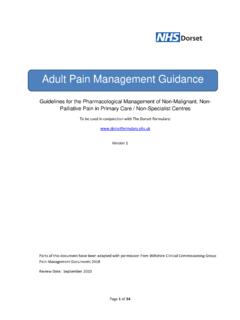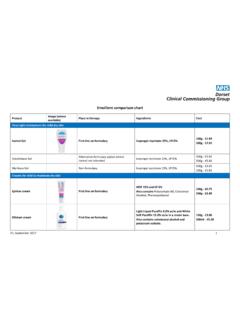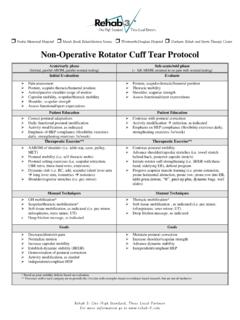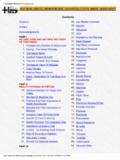Transcription of THE MANAGEMENT OF PSORIASIS IN ADULTS
1 DORSET MEDICINES ADVISORY GROUP THE MANAGEMENT OF PSORIASIS IN ADULTS PSORIASIS is a common, genetically determined, inflammatory and proliferative disorder of the skin, the most characteristic lesions consisting of chronic, sharply demarcated, dull-red, scaly plaques, particularly on the extensor prominences and in the scalp. Self-care advice Many people's PSORIASIS symptoms start or become worse because of a certain event, known as a trigger. Common triggers include: an injury to skin such as a cut, scrape, insect bite or sunburn (this is known as the Koebner response) drinking excessive amounts of alcohol smoking stress hormonal changes, particularly in women (for example during puberty and the menopause) certain medicines such as lithium, some antimalarial medicines, anti-inflammatory medicines including ibuprofen, ACE inhibitors (used to treat high blood pressure) and beta blockers (used to treat congestive heart failure) throat infections - in some people, usually children and young ADULTS , a form of PSORIASIS called guttate PSORIASIS (which causes smaller pink patches, often without a lot of scaling)
2 Develops after a streptococcal throat infection, although most people who have streptococcal throat infections do not develop PSORIASIS other immune disorders, such as HIV, which cause PSORIASIS to flare up or to appear for the first time Advice for patients can be found here MANAGEMENT pathway For people with any type of PSORIASIS assess: disease severity the impact of disease on physical, psychological and social wellbeing whether they have psoriatic arthritis the presence of comorbidities. Consider using the Dermatology quality of life assessment: Assess the severity and impact of any type of PSORIASIS : at first presentation before referral for specialist advice and at each referral point in the treatment pathway to evaluate the efficacy of interventions. Assess the impact of any type of PSORIASIS on physical, psychological and social wellbeing by asking: what aspects of their daily living are affected by the person's PSORIASIS how the person is coping with their skin condition and any treatments they are using if they need further advice or support if their PSORIASIS has an impact on their mood if their PSORIASIS causes them distress (be aware the patient may have levels of distress and not be clinically depressed) if their condition has any impact on their family or carers.
3 DORSET MEDICINES ADVISORY GROUP Treatment Pathway Step 1: general measures As with other chronic skin conditions time is needed by the GP or practice nurse to discuss the condition Provide a patient information leaflet (from British Association of Dermatologists (BAD)) Patient support groups Advise on a pre-payment certificate where appropriate Step 2: assess for related comorbidities Psoriatic arthritis recent studies suggest that the prevalence of psoriatic arthritis in patients with PSORIASIS may be up to 30%. Cardiovascular disease (CVD) there is a large amount of evidence pointing to an association between PSORIASIS and CVD. This is more apparent in cases of severe PSORIASIS It is important that healthcare professionals working with PSORIASIS patients including in cardiology, dermatology and general practice, need to target modifiable risk factors and have a lower threshold for investigating patients with cardiovascular symptoms Step 3: emollients Reduce the amount of scale by prescribing copious emollients - these make the skin more comfortable.
4 Several emollients are included in the Dorset formulary. There is no evidence that any one emollient is better than another. In general, ointments are preferred for use on dry skin, whereas creams and lotions can be used on less dry skin. Ointments may be poorly tolerated compared with creams; this may affect their acceptability, and hence adherence to their use. On first presentation, it may be useful to prescribe a trial of several emollients from the first line choices of the Dorset formulary (of small pack size), so that the person can make an informed choice as to which suits them best. The active treatments below should be used for PSORIASIS flare-ups until the plaques are controlled, with a treatment holiday between flare-ups when the use of regular emollients should still be encouraged. Step 4: topical treatments (see table 1)- choice based on individual requirements Use Calcipotrol (or combination with betamethasone, Dovobet gel or Enstilar foam) OD as first line to encourage a rapid improvement and hence compliance in chronic plaque PSORIASIS .
5 Dovobet gel can also be used on the scalp. The combinations are best avoided on areas of thin skin the face, flexures and the genitalia. Appropriate quantities ( 120g) should be prescribed, and the patient should always be advised to shake the bottle well, before application. Usual duration of therapy-4 weeks; if necessary, treatment may be continued beyond 4 weeks or repeated, on the advice of a specialist Large thin plaques - it is preferable to use tar preparations Exorex lotion Dithranol preparations, such as the short contact dithranol regime remain the most effective topical treatments but patient acceptability limits their use. In patients presenting with lesions that have thick scale it may be necessary to use de-scaling agents prior to commencing the treatments referred to above. Step 5: second line treatments (see table 2) Patients with moderate-severe PSORIASIS at the onset, and those who fail to respond adequately to topical treatments such be referred for consideration of second line treatments, which include: DORSET MEDICINES ADVISORY GROUP Phototherapy - most patients receive narrow band UVB known as TL01 therapy.
6 UVA therapy by way of PUVA is sometimes used. There is a maximum dose of light therapy that a patient may receive in a life time to limit the risks of skin cancer Ciclosporin - acts quickly. It is an immunosuppressive agent and so is best used in younger patients who have not already received light therapy. The main risks are of hypertension and renal damage, which limit how long the treatment can be given for. Methotrexate - is still one of the most effective treatments and it can also help some patients with psoriatic arthritis. The main risks are liver damage and bone marrow suppression which can occur in the early stages of treatment - patients should be advised to report immediately for a FBC if they have a sore throat or other signs of infection. Methotrexate cannot be used in pregnancy ( ). Acitretin - It can be particularly useful in hyperkeratotic hand / foot PSORIASIS . Acitretin is highly teratogenic and pregnancy needs to be avoided while on acitretin and for two years after, for this reason it is generally avoided in women of child bearing age Others drugs fumaric esters not routinely commissioned due to availability of licensed alternative (see below).
7 Step 6: apremilast, dimethyl fumarate and biologic agents (see table 3) Responsibility for use of systemic therapy should be in specialist settings only with the choice of agent and dosing schedule tailored to the needs of the individual. NICE CG 153 suggests this should include consideration of: the person's age disease phenotype, pattern of activity and previous treatment history disease severity and impact the presence of psoriatic arthritis (in consultation with a rheumatologist) conception plans comorbidities the person's views. The risks and benefits of the selected treatment should be explained using absolute risks and natural frequencies when possible. Apremilast is subject to additional monitoring including mood and weight for patients who are underweight at the start of treatment. Monitor people using systemic treatment for all types of PSORIASIS in accordance with national and local drug guidelines and policy see specific dug monitoring below.
8 Offer people with PSORIASIS who are starting treatment with a systemic non-biological or biological drug the opportunity to participate in long-term safety registries (for example the British Association of Dermatologists Biologic Interventions Register) Apremilast, dimethyl fumarate, Etanercept, Infliximab, Ixekizumab, Adalimumab, Secukinumab, Brodalumab and Ustekinumab are all approved as first line options within their respective TAs. They differ in their mode of action, method of delivery and review criteria. Follow the links for more details. Consider changing to an alternative drug in ADULTS ( rotating treatments if there is a loss of efficacy) or: the PSORIASIS does not respond adequately to a first drug as defined in NICE technology appraisals (at 10 weeks after starting treatment for infliximab, 12 weeks for etanercept, brodalumab, ixecizumab and secukinumab, and 16 weeks for apremilast, adalimumab and ustekinumab; primary failure) or the PSORIASIS initially responds adequately but subsequently loses this response, (secondary failure) or the first drug cannot be tolerated or becomes contraindicated.
9 For ADULTS in whom there is an inadequate response to a second drug, seek supra-specialist advice from a clinician with expertise in biological therapy. (This would be from Southampton Hospital). Some patients DORSET MEDICINES ADVISORY GROUP may not be able to tolerate the biological agents. MANAGEMENT Pathway for Scalp PSORIASIS Shampoo: for long-term MANAGEMENT Tar based preparations Polytar (plus) or Capasal shampoo are useful when scale is present - massage into the scalp for five minutes to allow the shampoo to penetrate the scale and then wash out Some patients are not keen on the smell of tar based preparations and may wish to try an alternative such as Dermax shampoo Topical applications: for flare-ups If the shampoo alone does not suffice add in a topical application Dovobet gel should be considered first line as it has the benefit of combining a topical steroid with a vitamin D analogue, and is proven to be superior when compared to using either agent alone.
10 massage in to a dry scalp, with the bottle being well shaken before application, and wash out the following morning with shampoo. Dovobet gel can leave the scalp feeling greasy and so it is recommended that shampoo is massaged in to the treated areas of the scalp and left on for about five minutes before washing off There are a number of alternatives to the Dovobet gel such as Betacap scalp application and Etrivex shampoo. It is best to avoid alcohol based solutions, which are not as well tolerated. Betacap needs to be left on the scalp, whereas Etrivex is a shampoo that needs to be massaged on to the scalp and left on for 20 minutes before washing out Thick scale Some patients present with thick scale and this needs to be removed before commencing the topical applications referred to above Sebco scalp ointment is very effective at removing scale - massage into affected areas of the scalp for five minutes and leave on for at least two hours, or overnight, before washing out with shampoo (some patients cannot tolerate the treatment for more than a few hours) The treatment is messy and so if left on overnight patients should use an old pillowcase or towel, alternatively the scalp can be occluded with a shower cap.















